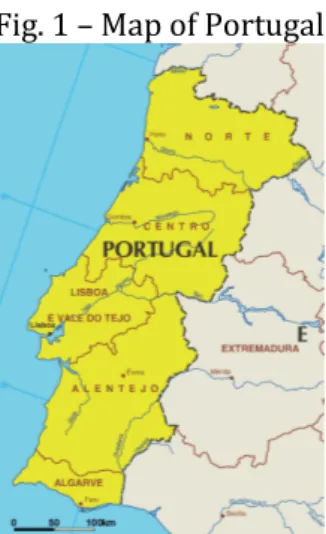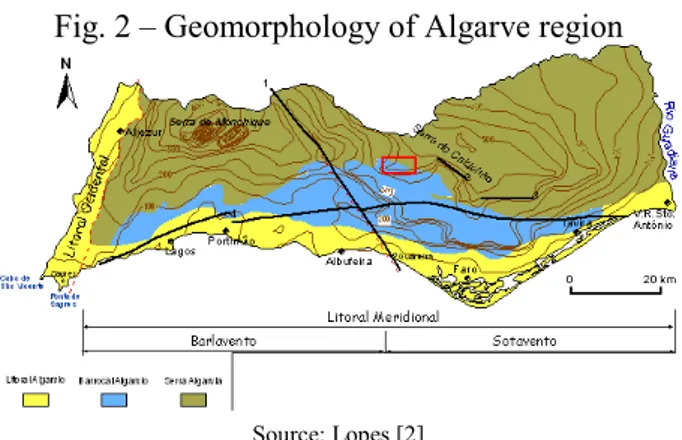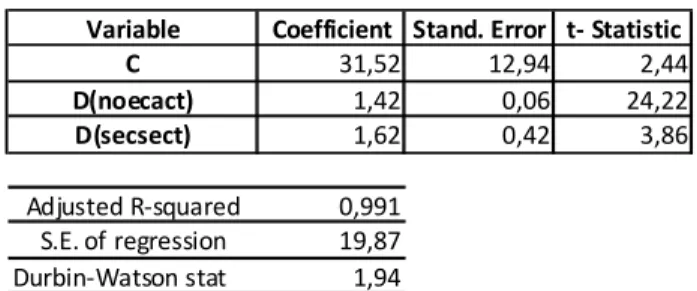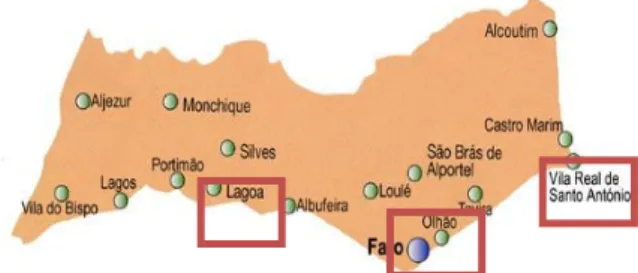1
Coastal areas also shrink:
Main determinants for the case of southern Portugal
ANA PAULA BARREIRA CIEO and Faculty of Economy
University of Algarve
Campus de Gambelas, P–8005–139 Faro PORTUGAL
E-mail: aprodrig@ualg.pt
Abstract: Portugal has facing a process of population displacement from the rural areas to major cities, commonly located along the Atlantic coast. As in the rest of Portugal, the Algarve registered during the 1960s the exodus from the rural areas, mainly to the Meridional Coast due the development of the touristic activity. Under this framework, we might be tempted to think that the coastal area of Algarve as an overall is demographically expanding. Although in general terms coastal municipalities have being facing a continued population growth, there is however some degraded areas, left abandoned and losing population. This analysis is relevant because problem recognition is required in order to implement policies to correct these phenomena. In order to find the determinants of population loss in some sub-areas of the Algarve Coast, panel data regressions were estimated, using for the time dimension the Census data for 1991 and 2001 years, and for the cross-section dimension 20 shrinking coastal territory sections. The major reasons for the existence of sub-areas shrinking in the Coast of Algarve are the absence of any economic activity in those places as well as the deindustrialization process. In order to deal with it some local governments good practices are shown by combining the creation of attractive conditions for the placement of new economic activities with strategies that cope historical and aesthetic concerns.
Key-Words: Shrinking Factors, Sustainable Development, Rehabilitation Policies, Panel Data Estimation.
1. Introduction
The phenomenon of shrinkage is common in several countries, being found either in Europe or in North America. The main reasons for spaces shrink are sub-urbanisation for larger cities; dismantling of old industries and deprived areas related with socioeconomic profile changes. In Portugal after a process of population displacement from the rural areas to major cities, commonly located along the Atlantic Coast, initiated in the 1960s, there was a population decline due the Portuguese emigration to Europe. In 1974 a democratic regime was implemented and the dictatorial regime in force until then was overthrown. With democracy, colonies were handed over to local management, leading to the decolonisation process. This exodus summed with the return of Portuguese emigrants, generated a population grew – Carrilho [1].
During the 1980s some cities faced loss of population due the increase of some small and medium sized cities but after the 1990s several cities recovered as a result of emigration outbreak accompanied by an increasing immigration. Nevertheless some cities such as Lisbon and Oporto, the two Portuguese major cities, never recovered.
The southern part of mainland Portugal – Algarve region – also felt a population decrease during the 1960s but since then, population have been increasing, principally during the 1970s and the1990s. However, the Algarve is a much differentiated territory, thus with different demographic dynamics.
The Algarve is bordered in the north by the Alentejo region, south and west by the Atlantic Ocean and east by the Guadiana River which marks the border with Spain - see Fig. 1.
Fig. 1 – Map of Portugal
2 Conditioned by the geology, the Algarve can be
divided into three main areas: Serra, Barrocal and Coast, being the two former in the interior part of Algarve. The coast is a narrow strip along the Atlantic Ocean divided into two spaces: the Vicentina Coast that covers the south-western coast of mainland Portugal and the most touristic beaches located at the southern part – Meridional Coast – see Fig.2. There is in this last space that most economic activity is found as well as the larger urban centres.
Fig. 2 – Geomorphology of Algarve region
Source: Lopes [2]
As in the rest of Portugal, the Algarve registered during the 1960s the exodus from the rural areas located at Barrocal and Serra to Coastal areas, mainly to the Meridional part due the development of the touristic activity. The following decades reflect a very diverse population growth by focusing predominantly on the coastal strip. In fact, while some municipalities like Albufeira, Lagoa and Portimão showed over 50% losses of rural population, the Albufeira municipality, with the major number of parishes located near the sea, increased 73.3%, between 1991 and 2001, the two last Census data – Sousa [3].
According to the latest demographic scenarios, the Algarve is the region of the country to record a higher population growth - 19.2% from 2003 to 2050, when the corresponding figure for Portugal will be a loss of 11% of the population – Sousa [3]. This projection reflects an increase on the number of southern coast inhabitants.
Under this framework, we might be tempted to think that the coastal area of Algarve as an overall is demographically expanding. Although in general terms coastal municipalities have being facing a continued population growth, there is however some degraded areas, left abandoned and losing population.
This analysis is only possible when we look to specific sections of the territory with smaller size than the parish. This analysis is relevant because
problem recognition is required in order to implement policies to correct these phenomena. The analysis of large numbers gives, in this framework, a completely different reading and inappropriate one. How then public actions aiming those territorial sections regeneration are justified, when the overall dynamics of the coastal zone is to increase the population?
Matters in this context to realize that even with coastal population increasing, sections in expansion will co-exist with depressed ones, requiring regeneration policies. With this purpose it is important to understand the historical context of these sections and what were the main determinants for those sections have been abandoned. Only this way public action can be taken to reverse this trend. Concepts like smart growth (Adelaja, Lake and Pennington [4]); smart shrinking (Nasser [5]) or sustainable communities (Roseland [6]) became important as defining strategies to deal with development and conservation.
2. Problem formulation
With a privileged position at sea, the Algarve coast has always been related to fishing, which joined a process of industrialization during the twentieth century, largely concentrated in the processing of raw materials, including fish and cork. In the late 1950s, international competition coupled with low technological capacity and consequent low productivity determined the phasing out of industrial activity. However, the geographic, environmental and climate of the Algarve allowed, from the 1960s, the development of tourism and related economic activities like trade and some services, which highlights the real estate business – Duarte, Barbosa and Lobo [7]. Tourism generates employment in the Algarve and was the main element for the attractiveness of population for the region described above.
Developments in recent years in the business of the Algarve meant a succession of deep changes in their social and territorial cohesion. The preponderance of the tourism sector has led to a rapid change in the productive structure, reducing the weight of primary sector, related to fishing, and an inhibition to the development of industrial activity, not only for its loss of international competitiveness but because tourism has come to compete for territorial occupation, leading to a lack of infrastructures to support other economic activities.
Given its relationship with the sea, Algarve developed several centres with canneries of fish.
3 Only to mention a few we can refer: Olhão,
Portimão and Vila Real de Santo António. Following the closure of the canneries in the Algarve region, areas and buildings previously assigned to that activity were abandoned, resulting into degraded areas. As such interventions that follow design principles in a sustainable way are required, which should take in consideration the spirit of the place, integrating the industrial existence into a new multifunctional landscape – Loures and Panagopoulos [8].
Simultaneously, the decreasing of fishing activity, devote to the abandonment some front sea areas, changing the aesthetics of the landscape. The gradual degradation of those spaces generated abandonment of people, contributing to aggravate the spiral of deterioration of buildings and surrounding areas. As consequence, the degraded areas attract no alternative economic activities, contributing to the rising of crime and insecurity in those areas.
The Algarve coast is thus an area of contradictions. Live side by side with huge growth areas associated with the development of tourism as well as with degraded areas because they lost their economic activity that either disappeared or is in decline. This work aims to understand the main reasons underlying the shrinkage of some sub-areas of the Algarve Coast. With this purpose was used information on 20 territorial sections of the Algarve Coast, which registered between 1991 and 2001 loss of inhabitants. Specific information regarding those sections was obtained from the Census Geo-Algarve. The observations include 3 sections from Vicentina Coast and the remaining ones from Meridional Coast.
Since the shrinkage phenomena can result from several factors, we aim to identify whether the abandonment of those sections was due to either of these factors: 1) an aging population, 2) an absence of relevant economic activity, 3) a result of the fishing abandonment or 4) an outcome from the closure of canning industries.
3. Estimation method
In order to find the determinants of population loss in sections of the Algarve Coast two panel data regressions were estimated: a static and in differences. For our empirical application we use panel data of T and N, time dimension and cross-section dimension, respectively. The time dimension refers to the Census data years: 1991 and 2001. The cross-sections are the 20 shrinking sections.
The considered dependent variable is the number of inhabitants (popres). For testing the factors underlying shrinking, four independent variables are identified: the aging index (ageindex), the number of inhabitants without any economic activity (noecact), the number of inahbitans working in the primary sector (primsect) and the number of inhabitants working in the secondary sector (secsect).
Pooled Ordinary Least Squares estimates (POLS) are commonly used, although the standard assumptions about the error processes are often violated, namely because errors tend to be serially correlated across time and cross-sections and tend to be groupwise heteroscedastic. If errors observe some of those effects, then the POLS estimates of the parameters will be consistent but inefficient. The violation of the assumptions about error processes can also be caused by model specification.
To deal with this problem, literature suggests the use of either of the two procedures: estimate a fixed effect model or a random effect model. Wooldridge [9] states that the distinction between the two models lies in the treatment of constant values. For the fixed effects model constant values are fixed, while for the random effects model the values listed are random variables. The author also points out that the fixed effects model are constant values that capture the behavioural differences of the units, i.e., that capture cross-section heterogeneity. In the random effects model are errors that capture the differences between units. This model performs deeper analysis, taking account of whether the residues are correlated with variables. Therefore, this model is more efficient than the fixed effects. The author also reports that the random effects model is the best model when the errors are not correlated with all independent variables.
Duarte, Wagner and Takamatsu [10] highlight the four properties of errors from random effects model: 1) have an average of 0, 2) have constant variance, i.e. the error is homoscedastic, 3) in the same unit at different periods of time the errors are not correlated, i.e. there is no autocorrelation, 4) that in different units at the same time there is no correlation, i.e., no autocorrelation contemporary. Aiming to choose the best explanatory model, we proceeded to estimate the parameters of functions, using the fixed effects model and random effects model. In order to test the properties mentioned, the Durbin-Watson test was performed which assesses the absence of autocorrelation between residuals in the analysis. If the test result is close to 2 that means the absence of autocorrelation.
4 This was the reason for selecting random effects
model for estimating the static panel data model: it i it it
popres =
β
x +u (1) whereβ
is the vector of unknown slope coefficients, assumed to be the same across cross-sections, xitis the set of regressors and uitis the error term.In order to complement the analysis, regression (1) in differences were also estimated, using POLS estimation due the lack of observations to run models by fixed effects or random effects. The static and in differences estimates are obtained using the Eviews 3.0 Program.
4. Estimation results
Tables 1 and 2 show the main results and reflects the best estimates. Either by the static or by in differences analysis, the only statistical relevant variables are the existence of inhabitants with no economic activity and the number of individuals employed by the secondary sector, i.e., employment in industrial activities. Neither the existence of elderly people nor the number of inhabitants in primary sector is statistical significant in any of the models estimated.
The major reason for the existence of shrinking zones in the Coast of Algarve is the absence of any economic activity. This result is very important since no action in order to reverse the shrinking process can be successfully promoted without strategies that begin by attracting economic activity to those places. The existence of economic activity will attract residents, sustaining population in a sustainable way.
Other relevant factor for shrinking in the Coast of Algarve is the outcome of the deindustrialization process. As pointed above, with the gradual canning factories displacement, buildings and
surrounding areas lye abandoned which is a repulsive factor of population.
Measures to overcome this situation have to combine rehabilitation strategies that respect heritage but also reconvert the places to new functions and new economic activities.
The abandon of the fishing activity at the region as well as the increase of the elderly in those sections play no role in explaining the shrinking phenomena faced in those places.
5. Problem solution
Public intervention regarding changing the demographic profile of those shrinking sections has first to act creating attractive conditions for the placement of new economic activities, reconciling that with strategies that cope historical and aesthetic concerns.
Some local governments of the region have already in place some good examples of such a compromise. However, there are others that can be questionable.
Fig. 3 shows three municipalities in which local governments have being developing a strategy to deal with the existing shrinking sections. Some actions are already taken or are ongoing, others are still intentions.
Public intervention proposed for degraded areas in the three sections under consideration was very similar. Given that tourism is the main economic activity in the Algarve, local governments have adopted policies for the recovery of the buildings and surrounding areas, giving them uses that can be enjoyed by residents and tourists alike.
In Olhão, the restoring of the maritime area of consisted in building the first five-star hotel project in the county and constructing a marina. The new hotel aims to harness the potential of the Ria Formosa on the environment and further develop tourism of business and health. Olhão and Vila
Variable Coefficient Stand. Error t- Statistic
C 31,52 12,94 2,44 D(noecact) 1,42 0,06 24,22 D(secsect) 1,62 0,42 3,86 Adjusted R-squared 0,991 S.E. of regression 19,87 Durbin-Watson stat 1,94
Table 1 - Static Model Estimation Random Effects Model (RE)
Dependent Variable: D(popres) Method: GLS Transformed Regression
Variable Coefficient Stand. Error t- Statistic
C -5,29 9,48 -0,56 D(noecact) 1,37 0,09 15,61 D(secsect) 1,45 0,55 2,63 Adjusted R-squared 0,945 S.E. of regression 19,07 F-statistic 162,95
Table 2 - Estimation in differences Pooled Least Squares (POLS) Dependent Variable: D(popres)
5 Real de Santo António are integrated into a laguna
system called Ria Formosa.
Fig. 3 – Coastal areas of Algarve implementing rehabilitation policies
Source: http://www.mapas-portugal.com Joining the already completed intervention, is planned the rehabilitation of the historical area of Olhão, a contiguous space from the one already recovered. With unique architecture features in the country, the architecture of the historical area of Olhão shows the Arab influence in the region. The rehabilitation of the historical area includes the recovering of facades, renovation of degraded buildings and arrangement of outdoor spaces. The local government of Vila Real de Santo António city is also preparing a public intervention, rehabilitating the degraded areas of the old area of Ponta da Areia, consisting of ancient factories areas. This area of the town is occupied by shipyard and old industrial and storage buildings, most in dilapidated conditions.
With the objective of promoting the regeneration of the area, the construction of hotels is planned. The recovery of the area includes also the construction of buildings placed around large gardens that make a transition from urban landscape to the sea and surrounding green spaces.
Two principal actions were taken regarding the public intervention in Lagoa. By one hand, an old cannery fish near the mouth of the river Arade was reborn as a multifunctional complex, aiming of boosting the market for conferences, meetings and seminars in southern Portugal. The so-called Congress Centre of Arade or Arade Pavilion is a daring architectural project, divided into two blocks and equipped with high technologies essential to large-scale international shows. In the exterior stands the imposing chimney, a remnant of the old factory.
By other hand, left river-side of Arade will be rehabilitated. Currently, are planned the construction of a marina and an intervention at the river margins. This is an essential work for this zone, since the estuary of the Arade River has great tourism potential and should not be abandoned. The
building of a Hôtel near the Congress Centre of Arade is also projected.
Despite these three examples, we cannot state that all decisions taken by local governments considers the specificities of the places and evolves inhabitants in the decision process of building new facilities or preserving heritage. Citing Loures, Viegas and Panagopoulos [11] interventions devoted to post-industrial landscapes are frequently reprehensible, contributing to the disappearance of various buildings with significant meaning. The authors refer that is a mistake the preservation of old industrial chimneys as a symbol when the entire industrial landscape is not properly considered. The Arade Pavillion has been subject to criticism because a new building was erected; only retaining the chimney from the old one. Andrade [12] also noted, for the case of Vila Real de Santo António, a reduced involvement of people in public choices that have been implemented in the former industrial zone.
6. Conclusion
In recent years the coastal area of Portugal has registered significant population increase. The Algarve in particular, in addition to having attracted people from within the region and elsewhere, has shown a dynamic for attracting people to the coast, mainly for the Meridional Coast as a result of tourism development, which became the main economic activity. While most of the sections of the Algarve Coast record expansion, it is difficult to pass a speech that there are areas of sea front degraded and requiring rehabilitation measures. To guide policy measures is necessary to understand the factors underlying the shrinking of certain sections of the coastal territory. Using panel data estimations, factors explaining shrinkage in sections of the Algarve Coast are identified. Shrinking is due to a combination of two factors: the absence of an economic activity that sustains the population and the collapse of industries, devoting buildings and adjacent areas to degradation.
Given this reality, although there remains a lot of action in the Algarve to be developed, there are already some good examples of local governments promoting the regeneration of sea front areas. Given the profile of shrinkage identified, those local governments are already aware that interventions will have to consider the economic revitalization of spaces.
The local government of Olhão is preserving the county heritage as a factor for revaluation of Olhão
6 and for the setting of new residents. The main goal
of local council is to contribute for the reinforcement of the touristic strategy of the municipality.
With the restoration of the sea front, in which the entire public space will be renewed, including the area of Ponta da Areia, the council mayor of Vila Real de Santo António expects to create a residential and tourist area.
The renewal of the Arade River margins in Lagoa with the construction of the marina has the intention of receiving large luxury ships. This goal is due to the growth that this segment has being facing, after the development of nautical tourism that Algarve has been witnessed. The rehabilitation of Lagoa front sea also considers the building of a large number of apartments in the resort and luxury villas integrated in the fishing environment that embraces these new constructions, both from the architectural and social points of view. The goal is to improve touristic activity, attracting new inhabitants to the place.
In the three cases, the main driver of urban regeneration policy has been the local government. The local government through the policy instruments of both land use and environment, proposed actions for the degraded areas rehabilitation. Associated with public intervention emerged the interest of individuals and companies in boosting economically those areas, mainly from tourism and real estate activity, making them attractive and profitable areas. The growth of economic activity promotes the creation of wealth in the area, increasing quality of life and attracting inhabitants.
References:
[1] Carrilho, M. J., Patrício, L., The recent demographic situation in Portugal (A situação demográfica recente em Portugal), Revista de Estudos Demográficos, Vol.32, No.2, 2002, pp.147-176.
[2] Lopes, F., Rocha da Pena (Loulé, Algarve): ao encontro da geodiversidade, 2006, Available at: {http:\\rochadapena.no.sapo.pt}
[3] Sousa, V. D., The need for reinvention of the paradigm of rural development - a reflection from the case of Algarve (A necessidade de reinvenção do paradigma de desenvolvimento rural – uma reflexão a partir do caso algarvio), VI Congresso Português de Sociologia – Mundos Sociais: Saberes e Práticas, No.16, 2008, 14 pp.
[4] Adelaja, J. A. H., Lake, M. B., Pennington, S., Tenets of Smart Growth in Michigan. Michigan:
Michigan State University, Land Policy Program, Presented at Michigan Land Use Summit, 2 and 3 February 2004.
[5] Nasser, H. E., As older cities shrink, some reinvent themselves, Accessed at 6 July 2009 at: http://www.usatoday.com/news/nation/2006-12-26-shrinking-cities-cover_x.htm, USA Today, 2006. [6] Roseland, M., Toward Sustainable Communities: Resources for citizens and their governments, 3ª Ed. Gabriola Island, Canada: New Society Publishers, 2005, 239p.
[7] Duarte, R., Barbosa, A. S., Lobo, M. L. C., Tourism as an integrant factor in development planning: The case of Vilamoura, Algarve, Portugal, and S. Sebastian, Alcatrazes Coast, Brazil (O turismo como factor integrante no desenvolvimento do território: o caso de Vilamoura, Algarve, em Portugal, e S. Sebastião, Costa de Alcatrazes, no Brasil), Pesquisa e Tecnologia MINERVA, Vol.5, No.2, 2008, pp.111-119.
[8] Loures, L., Panagopoulos, T., Reclamation of derelict industrial land in Portugal: Greening is not enough, Int. J. Sus. Dev. Plann., Vol.0, No.0, 2008, pp.1-8.
[9] Wooldridge, J., Introductory Econometrics – A modern approach, (3th Edition), Michigan State University, Thomson South-Western, 2006.
[10] Duarte, P., Wagner, L., Takamatsu, R., Econometric Models for Panel Data: Theoretical Aspects and Application Examples of research in Accounting and Finance (Modelos Econométricos para Dados em Painel: Aspectos Teóricos e Exemplos de Aplicação à pesquisa em Contabilidade e Finanças), Artigo apresentado no 4º Congresso da USP – Iniciação Científica em Contabilidade, São Paulo, 26 e 27 de Junho, 2007. [11] Loures, L., Viegas, A., Panagopoulos, T., Post-Industrial Landscapes – The Case of the Arade River left Margin, New Models for Innovative Management and Urban Dynamics, COST Action TU602, 2009, pp.65-75.
[12] Andrade, R., Recovery of Degraded Industrial Zones: The Case of Vila Real de Santo António (Recuperação de Zonas Industriais Degradadas: o Caso de Vila Real de Santo António), University of Algarve - Faculty of Science and Technology - Department of Marine Sciences of the Earth and the Environment - Report of the Graduation of Landscape Architecture, 2010.



